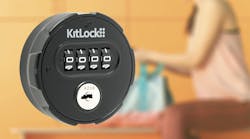Usage and Range
Q: When should I use wireless transceivers and what kind of range can I expect in a building?
A: There are a variety of ways that wireless signals are used in access-control systems. A wireless channel can be used between controllers and the central controller; between credential readers and the door controllers; or between controllers and locks or sensors.
Wireless is a viable choice when a wired connection is not an option and/or when the costs of pulling hardwire is equal to or more than the cost of the required transmitting and receiving equipment. Use of wireless equipment may allow the job to be completed with less labor to offset the cost of additional equipment. Some systems allow you to use whichever method is most cost effective on the same system.
The kind of range you can expect in a building depends on the construction of the building and the equipment used. Most manufacturers cite a typical outdoor line-of-sight range of up to 1,000 feet and a range inside the building from 300 to 500 feet. Because the RF signals will penetrate wood, concrete and stone, but not metal, the range will vary from building to building and perhaps within the building.
Choosing THE RIGHT Equipment
Q: How can I be sure the equipment is going to work in the job I am bidding? Do I need an FCC license to operate the system?
A: For most systems, temporarily installing the equipment you will use is the most effective way to know for sure. Testing before the building construction is completed is not effective because large metal objects, such as heating and air-conditioning ducts, structural beams and posts, large pieces of metal-backed insulation, etc. can impact the range.
Systems use a variety of antennas to focus the signals and most use either the 900Mhz or 2.4Ghz frequencies to communicate. Because both of these frequency ranges are used by other devices, some manufacturers use spread spectrum technology to reduce interference and also reduce the chance of illegal monitoring.
To enhance system reliability, storing or buffering transactions and databases used to validate users at the door reduces any problems created by lapses in communications. Some systems include the use of regular phone lines with automatic dial-up communication when a device buffer is full. Others simply use the wireless communications path to send data to the main controller before buffers overflow.
Most manufacturers use unlicensed frequency bands so no license is required.
Wireless Minimizes Lightning Problems
Q: Can wireless systems minimize lightning problems?
A: Yes, because eliminating long wire runs reduces one of the biggest sources of lightning damage. Using wireless communications removes a path that a lightning-induced surge would use to enter the controller’s communications circuits and cause damage.
Brad Shipp is a former Executive Director and Training Director for the NBFAA where he authored several NTS courses, including the Access Control Certification course. His involvement in the access control industry dates back to 1974 and, in 1986, he became an instructor for the NBFAA National Training School. Shipp has served on several law enforcement, regulatory and industry association boards and has been honored for his service by the False Alarm Reduction Association and the International Association of Security and Investigative Regulators. Send in your access control questions to [email protected].

